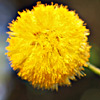Sweet Acacia is a woody shrub up to 7 m high, but usually is not higher than 4 m, very branched with an intricate habit, very spiny. The bark is grey-brown smooth or scaly. The branches are glabrous, purplish to gray with zigzagged form. The alternate leaves are shortly petiolated, bipinnate with 2-4 pairs of pinnulae having 8-10, up to 20, pairs of leaflets 10–12 pairs, minute, 2–7 mm long, 0.75–1.75 mm wide, glabrous, leathery. Stipulate axillary pairs of thorns 0.2-3 cm long. This tree is deciduous over part of its range, but evergreen in most locales including Israel.
Flowers of an yellow color, very fragrant with a smell of violet, grouped in 50 or more in globose heads 1.5-2.0 cm in diameter, grouped by 2-3, or isolated on an 8-35 mm long slender, hairy-downy peduncle.
The fruits of Acacia farnesiana are indehiscent green cigar-like straight pods, turning black or dark brown at maturity. They are 4-8 cm long and 0.8-1.5 cm in diameter, each contains 12 to 14 seeds. The chestnut-brown seeds transversally set in the pods embedded in a dry spongy whitish tissue. They are ovoid, compressed, 6-7 x 4-5 mm.
Acacia farnesiana thrives in dry localities and it is drought hardy and fire resistant. It can be found at elevations between sea level and 1300 m. The species is reported to exhibit tolerance to drought, high pH, heat, low pH, salt, sand, and slope. It forms symbiotic relation with Rhizobium allowing it to grow in nitrogen poor soils. Thrives on poor, dry soils but favors deeper, moister, more fertile clayey soils.
Acacia farnesiana origin is in Mexico and Central America. This species was given its name since it was introduced to Europe in the 17th century to the Farnese Gardens, created in 1550 on the northern portion of Palatine Hill in Rome, Italy, by Cardinal Alessandro Farnese, and was the first private botanical gardens in Europe. Since then it spread and became naturalized in many of the world's subtropical and tropical arid lands: North Africa, Sahel, East Africa, Arabian Peninsula, The Middle East, Pakistan, India, The Pacific, and Australia. It remains unclear whether the Pacific-Australian distribution is primarily natural or anthropogenic. It is believed to have been introduced to Australia before European settlement, as the first British explorers of interior Australia found it growing all over the interior northern part of the continent. In recent times it has become a serious invasive along waterways in parts of Australia, including north-west New South Wales, where it now infests thousands of acres of grazing country and may form spiny thickets that prevent access to grazing animals.
Sweet Acacia has been distributed by humans to many parts of the world because of its many uses. In Israel and other parts of the Middle East it is mainly known as an impenetrable hedge planted for protection of orchards and gardens, but it has been used in a multitude of ways in other countries.
Both A. farnesiana and its var cavenia are extensively cultivated in and around Cannes, southern France, which is the center for production of the perfume cassie that is widely used in the perfume industry in Europe. Extraction of the fragrant essential oils which contain the sesquiterpenoid farnesol, named after this plant, from its flowers is done in hydrophobic solvents. Aromatic ointments are made in India by immersion of the flowers in fat.
The flowers make good forage for bees. The foliage and green pods constitute a significant source of forage in much of its range, with a protein content of around 18%. Eating of the pods by ungulates assists in the spread of the seeds/. Roasted pods have also been used as food by the Australian Aborigines, and they are recommended for sweet and sour dishes. The ripe seeds can be put through a press to make oil for cooking.
A black dye can be obtained from the pods, and in some parts of India, the bark and pods are used as dye-stuff and for tanning. The bark is used for its tannin content. It also exudes a gum similar to gum Arabic that can be used as a natural adhesive.
The wood of Acaia farnesiana is hard and durable underground. It is used for wooden plows and for pegs. The woody branches are used in India as tooth brushes. It used for treating variety of medical conditions in traditional medicine practices in South America, Africa and Asia.
Written by Amram Eshel







